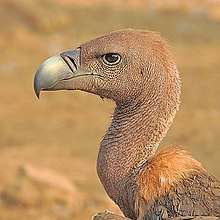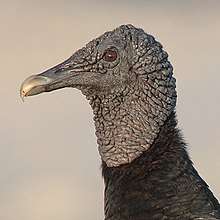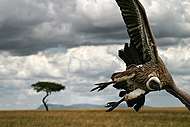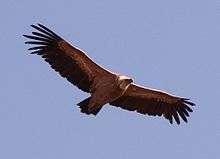Vulture
A vulture is a scavenging bird of prey. The two types of vultures are the New World vultures, including the Californian and Andean condors, and the Old World vultures, including the birds that are seen scavenging on carcasses of dead animals on African plains. Some traditional Old World vultures (including the bearded vulture) are not closely related to the others, which is why the vultures are to be subdivided into three taxa rather than two. New World vultures are found in North and South America; Old World vultures are found in Europe, Africa, and Asia, meaning that between the two groups, vultures are found on every continent except Australia and Antarctica (though Trigonoceps vultures have crossed the Wallace line).[2]
| Vulture | |
|---|---|
 | |
| White-rumped vulture (old world)
Mangaon, India | |
 | |
| Black vulture (new world)
Farallon, Panama | |
| Scientific classification | |
| Kingdom: | |
| Phylum: | |
| Class: | |
| Families | |
|
Accipitridae (Aegypiinae) | |
A particular characteristic of many vultures is a bald head, devoid of normal feathers. Although it has been historically believed to help keep the head clean when feeding, the bare skin may play an important role in thermoregulation.[3] Vultures have been observed to hunch their bodies and tuck in their heads in the cold, and open their wings and stretch their necks in the heat. Vultures also use urine as a way to keep themselves cool by urinating on themselves.[4]
A group of vultures is called a kettle, committee or wake.[5] The term kettle refers to vultures in flight, while committee refers to vultures resting on the ground or in trees.[5] Wake is reserved for a group of vultures that are feeding.[5] The word Geier (taken from the German language) does not have a precise meaning in ornithology; it is occasionally used to refer to a vulture in English, as in some poetry.
Old World vulture
The Old World vultures found in Africa, Asia, and Europe belong to the family Accipitridae, which also includes eagles, kites, buzzards, and hawks. Old World vultures find carcasses exclusively by sight.
The 16 species in 9 genera are:
- Cinereous vulture, Aegypius monachus
- Griffon vulture, Gyps fulvus
- White-rumped vulture, Gyps bengalensis
- Rüppell's vulture, Gyps rueppelli
- Indian vulture, Gyps indicus
- Slender-billed vulture, Gyps tenuirostris
- Himalayan vulture, Gyps himalayensis
- White-backed vulture, Gyps africanus
- Cape vulture, Gyps coprotheres
- Hooded vulture, Necrosyrtes monachus
- Red-headed vulture, Sarcogyps calvus
- Lappet-faced vulture, Torgos tracheliotos
- White-headed vulture, Trigonoceps occipitalis
- Bearded vulture (Lammergeier), Gypaetus barbatus
- Egyptian vulture, Neophron percnopterus
- Palm-nut vulture, Gypohierax angolensis
New World vultures
The New World vultures and condors found in warm and temperate areas of the Americas are not closely related to the similar Accipitridae, but belong in the family Cathartidae, which was once considered to be related to the storks. However, recent DNA evidence suggests that they should be included among the Accipitriformes, along with other birds of prey. However, they are still not closely related to the other vultures. Several species have a good sense of smell, unusual for raptors, and are able to smell dead animals from great heights, up to a mile away.
The seven species are:
- Black vulture Coragyps atratus in South America and north to the US
- Turkey vulture Cathartes aura throughout the Americas to southern Canada
- Lesser yellow-headed vulture Cathartes burrovianus in South America and north to Mexico
- Greater yellow-headed vulture Cathartes melambrotus in the Amazon Basin of tropical South America
- California condor Gymnogyps californianus in California, formerly widespread in the mountains of western North America
- Andean condor Vultur gryphus in the Andes
- King vulture Sarcoramphus papa from southern Mexico to northern Argentina
Feeding
Vultures are scavengers, meaning they eat dead animals. They rarely attack healthy animals, but may kill the wounded or sick. When a carcass has too thick a hide for its beak to open, it waits for a larger scavenger to eat first.[6] Vast numbers have been seen upon battlefields. They gorge themselves when prey is abundant, until their crops bulge, and sit, sleepy or half torpid, to digest their food. These birds do not carry food to their young in their talons but disgorge it from their crops. The mountain-dwelling bearded vulture is the only vertebrate to specialize in eating bones,[7] and does carry bones to the nest for the young, and it hunts some live prey.
Vultures are of great value as scavengers, especially in hot regions. Vulture stomach acid is exceptionally corrosive (pH=1.0[7]), allowing them to safely digest putrid carcasses infected with botulinum toxin, hog cholera bacteria, and anthrax bacteria that would be lethal to other scavengers[8] and remove these bacteria from the environment. New World vultures often vomit when threatened or approached. Contrary to some accounts, they do not "projectile vomit" on their attacker in defense, but to lighten their stomach load to ease take-off. The vomited meal residue may distract a predator, allowing the bird to escape.[9]
New World vultures also urinate straight down their legs; the uric acid kills bacteria accumulated from walking through carcasses, and also acts as evaporative cooling.[10]
_%26_Indian_vulture_(Gyps_indicus)_Photograph_by_Shantanu_Kuveskar.jpg) Healthy flock of Indian vultures (Gyps indicus) & White-rumped vultures (Gyps bengalensis) from Mangaon, Maharashtra, India in March 2020
Healthy flock of Indian vultures (Gyps indicus) & White-rumped vultures (Gyps bengalensis) from Mangaon, Maharashtra, India in March 2020_0.jpg) Gyps fulvus eating a red deer carcass in Spain
Gyps fulvus eating a red deer carcass in Spain Vulture, preparing to land in Kenya
Vulture, preparing to land in Kenya- A wake (group of feeding vultures) of white-backed vultures eating a wildebeest carcass at Maasai Mara, Kenya
Conservation status
Vultures in south Asia, mainly in India and Nepal, have declined dramatically since the early 1990s.[11] It has been found that this decline was caused by residues of the veterinary drug Diclofenac in animal carcasses.[12] The government of India has taken very late cognizance of this fact and has banned the drug for animals.[13] However, it may take decades for vultures to come back to their earlier population level, if they ever do: without vultures to pick corpses clean, rabies-carrying dogs have multiplied, feeding on the carrion, and age-old practices like the sky burials of the Parsees are coming to an end, permanently reducing the supply of corpses.[14] The same problem is also seen in Nepal where government has taken some late steps to conserve remaining vultures. Similarly, in Central Africa there has also been efforts to conserve the remaining vultures and bring their population numbers back up. This is largely due to the bushmeat trade, "it is estimated > 1 billion kg of wild animal meat is traded" and vultures take up a large percentage of this bushmeat due to their demand in the fetish market.[15] The substantial drop in vulture populations in the continent of Africa is also said to be the result of both intentional and unintentional poisoning, with one study finding it to be the cause of 61% of the vulture deaths recorded.[16]
The vulture population is threatened across Africa and Eurasia. There are many anthropogenic activities that threaten vultures such as poisoning and wind energy collision mortality.[17]
A recent study in 2016, reported that "of the 22 vulture species, nine are critically endangered, three are endangered, four are near threatened, and six are least concern".[18]
The conservation status of vultures is of particular concern to humans. For example, the decline of vulture populations can lead to increased disease transmission and resource damage, through increased populations of disease vector and pest animal populations that scavenge carcasses opportunistically. Vultures control these pests and disease vectors indirectly through competition for carcasses.[19]
On the 20th of June 2019, the corpses of 468 white-backed vultures, 17 white-headed vultures, 28 hooded vultures, 14 lappet-faced vultures and 10 cape vultures, altogether 537 vultures, besides 2 tawny eagles, were found in northern Botswana. It is suspected that they died after eating the corpses of 3 elephants that were poisoned by poachers, possibly to avoid detection by the birds, which help rangers to track poaching activity by circling above where there are dead animals.[20][21][22][23]
See also
- Jatayu
- Stele of the Vultures
References
- "Fossilworks:Aegypiinae". Fossilworks. Retrieved September 4, 2018.
- Hanneke J.M.; et al. "Continental-style avian extinctions on an oceanic island" (PDF). Repository.si.edu. Retrieved 17 October 2018.
- Ward, J.; McCafferty, D.J.; Houston, D.C.; Ruxton, G.D. (April 2008). "Why do vultures have bald heads? The role of postural adjustment and bare skin areas in thermoregulation". Journal of Thermal Biology. 33 (3): 168–173. doi:10.1016/j.jtherbio.2008.01.002.
- Arad, Zeev; Bernstein, Marvin H. (2 March 1988). "Temperature Regulation in Turkey Vultures". The Condor. 90 (4): 913–919. doi:10.2307/1368848. JSTOR 1368848.
- Galván, Javier (2014). They Do What? A Cultural Encyclopedia of Extraordinary and Exotic Customs from around the World. Santa Barbara, California: ABC-CLIO. p. 289. ISBN 978-1-61069-342-4.
- "Fast Vulture Facts". WebVulture.com. Archived from the original on July 18, 2011. Retrieved February 15, 2013.
- Buechley, Evan R.; Sekercioglu, Cagan H. (2016). "Vultures". Current Biology. 26 (13): R560–R561. doi:10.1016/j.cub.2016.01.052. PMID 27404248.
- Caryl, Jim (September 7, 2000). "Re: How come that vultures can resist dangerous toxins when feeding on carcass". MadSci Network. Retrieved February 15, 2013.
- "Turkey Vulture Facts". Turkey Vulture Society. Retrieved 2012-12-01.
- Conger, Cristen (2008-10-13). "Why is it a bad idea to scare a vulture?". HowStuffWorks. Retrieved February 15, 2013.
- Prakash, V.; Pain, D.J.; Cunningham, Arthur A.; Donald, P.F.; Prakash, N.; Verma, A.; Gargi, R.; S. Sivakumar, S. and Rahmani, A.R.; ‘Catastrophic collapse of Indian white-backed Gyps bengalensis and long-billed Gyps indicus vulture populations’; Biological Conservation, 109 (2003), pp. 381-390
- Oaks, J. Lindsay; Gilbert, Martin; Virani, Munir Z.; Watson, Richard T.; Meteyer, Carol U.; Rideout, Bruce A.; Shivaprasad, H. L.; Ahmed, Shakeel; Chaudhry, Muhammad Jamshed Iqbal; Arshad, Muhammad; Mahmood, Shahid; Ali, Ahmad; Khan, Aleem Ahmed (February 12, 2004). "Diclofenac residues as the cause of vulture population decline in Pakistan". Nature. 427 (6975): 630–633. Bibcode:2004Natur.427..630O. doi:10.1038/nature02317. PMID 14745453.
- Prakash, Vibhu; Bishwakarma, Mohan Chandra; Chaudhary, Anand; Cuthbert, Richard; Dave, Ruchi; Kulkarni, Mandar; Kumar, Sashi; Paudel, Khadananda; Ranade, Sachin; Shringarpure, Rohan; Green, Rhys E. (November 7, 2012). "The Population Decline of Gyps Vultures in India and Nepal Has Slowed since Veterinary Use of Diclofenac was Banned". PLOS One. 7 (11): e49118. Bibcode:2012PLoSO...749118P. doi:10.1371/journal.pone.0049118. PMC 3492300. PMID 23145090.
- van Dooren, Thom (May 2011). "Vultures and their People in India: Equity and Entanglement in a Time of Extinctions". Australian Humanities Review (50).
- Buij, R.; Nikolaus, G.; Ogada, D.; Whytock, R.; Ingram, D.J. (August 2015). "Trade of threatened vultures and other raptors for fetish and bushmeat in West and Central Africa". Fauna & Flora International. EBSCOhost. 50 (4): 606–616. doi:10.1017/S0030605315000514.
- Ogada, Darcy; Shaw, Phil; Beyers, Rene L.; Buij, Ralph; Murn, Campbell; Thiollay, Jean Marc; Beale, Colin M.; Holdo, Ricardo M.; Pomeroy, Derek (2016-03-01). "Another Continental Vulture Crisis: Africa's Vultures Collapsing toward Extinction". Conservation Letters. 9 (2): 89–97. doi:10.1111/conl.12182. ISSN 1755-263X.
- Santangeli, A., Girardello, M., Buechley, E., Botha, A., Minin, E. D., & Moilanen, A. (2019). Priority areas for conservation of Old World vultures. Conservation Biology.
- Buechley, Evan R.; Şekercioğlu, Çağan H. (2016-06-01). "The avian scavenger crisis: Looming extinctions, trophic cascades, and loss of critical ecosystem functions]". Biological Conservation. 198: 220–228. doi:10.1016/j.biocon.2016.04.001.
- O'Bryan, Christopher J.; Holden, Matthew H.; Watson, James E. M. (2019). "The mesoscavenger release hypothesis and implications for ecosystem and human well-being". Ecology Letters. 0 (9): 1340–1348. doi:10.1111/ele.13288. ISSN 1461-0248. PMID 31131976.
- "Over 500 Rare Vultures Die After Eating Poisoned Elephants In Botswana". Agence France-Press. NDTV. 2019-06-21. Retrieved 2019-06-28.
- Hurworth, Ella (2019-06-24). "More than 500 endangered vultures die after eating poisoned elephant carcasses". CNN. Retrieved 2019-06-28.
- Solly, Meilan (2019-06-24). "Poachers' Poison Kills 530 Endangered Vultures in Botswana". Smithsonian. Retrieved 2019-06-28.
- Ngounou, Boris (2019-06-27). "BOTSWANA: Over 500 vultures found dead after massive poisoning". Afrik21. Retrieved 2019-06-28.
External links
| Wikimedia Commons has media related to Vultures. |
| Wikiquote has quotations related to: Vulture |
| Look up vulture in Wiktionary, the free dictionary. |

_Close-up_by_Shantanu_Kuveskar.jpg)
_Flock_gathered_near_carcass_Photograph_by_Shantanu_Kuveskar.jpg)
%2C_Kruger_National_Park.jpg)
